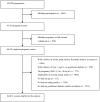Self-Reported Eating Speed and Incidence of Gestational Diabetes Mellitus: the Japan Environment and Children's Study
- PMID: 32370156
- PMCID: PMC7282250
- DOI: 10.3390/nu12051296
Self-Reported Eating Speed and Incidence of Gestational Diabetes Mellitus: the Japan Environment and Children's Study
Abstract
There is little evidence linking eating speed to gestational diabetes mellitus (GDM) incidence. We therefore aimed to evaluate the prospective association of eating speed with GDM incidence. Overall, 97,454 pregnant women were recruited between January 2011 and March 2014. Singleton pregnant women who did not have GDM, heart disease, stroke, cancer, type 1 diabetes, and/or type 2 diabetes at the time of study enrollment were eligible. Each woman was asked about her eating speed at that time via a questionnaire. Odds ratios of GDM in relation to eating speed were obtained using logistic regression. Among the 84,811 women eligible for analysis, 1902 cases of GDM were identified in medical records. Compared with women who reported slow eating speed, the age-adjusted odds ratios (95% confidence interval) of GDM for women who reported medium, relatively fast, or very fast eating speed were 1.03 (0.90, 1.18), 1.07 (0.94, 1.23), and 1.28 (1.05, 1.58), respectively. Adjustment for demographic, lifestyle-related, and dietary factors including dietary fat, dietary fiber, and energy intakes yielded similar results. The association was attenuated and no longer significant after further adjustment for pre-pregnancy body mass index. The mediation analysis showed that being overweight accounted for 64% of the excess risk of GDM associated with eating speed. In conclusion, women who reported very fast eating speed, compared with those reporting slow eating speed, were associated with an increased incidence of GDM, which may be largely mediated by increased body fat.
Keywords: cohort study; eating speed; gestational diabetes; prevention.
Conflict of interest statement
The authors declare no conflict of interest.
Figures
Similar articles
-
Skipping breakfast before and during early pregnancy and incidence of gestational diabetes mellitus: the Japan Environment and Children's Study.Am J Clin Nutr. 2020 Apr 1;111(4):829-834. doi: 10.1093/ajcn/nqaa014. Am J Clin Nutr. 2020. PMID: 32020171
-
Soy consumption and incidence of gestational diabetes mellitus: the Japan Environment and Children's Study.Eur J Nutr. 2021 Mar;60(2):897-904. doi: 10.1007/s00394-020-02294-1. Epub 2020 Jun 6. Eur J Nutr. 2021. PMID: 32506178
-
Fresh fruit intake in pregnancy and association with gestational diabetes mellitus: A prospective cohort study.Nutrition. 2019 Apr;60:129-135. doi: 10.1016/j.nut.2018.09.022. Epub 2018 Oct 24. Nutrition. 2019. PMID: 30572275
-
Prepregnancy Habitual Intakes of Total, Supplemental, and Food Folate and Risk of Gestational Diabetes Mellitus: A Prospective Cohort Study.Diabetes Care. 2019 Jun;42(6):1034-1041. doi: 10.2337/dc18-2198. Epub 2019 Apr 22. Diabetes Care. 2019. PMID: 31010874 Free PMC article.
-
Risk of gestational diabetes mellitus in women achieving singleton pregnancy spontaneously or after ART: a systematic review and meta-analysis.Hum Reprod Update. 2020 Jun 18;26(4):514-544. doi: 10.1093/humupd/dmaa011. Hum Reprod Update. 2020. PMID: 32441298 Free PMC article.
Cited by
-
Nutrition for Gestational Diabetes-Progress and Potential.Nutrients. 2020 Sep 3;12(9):2685. doi: 10.3390/nu12092685. Nutrients. 2020. PMID: 32899109 Free PMC article.
-
Eating Speed, Physical Activity, and Cardiorespiratory Fitness Are Independent Predictors of Metabolic Syndrome in Korean University Students.Nutrients. 2021 Jul 15;13(7):2420. doi: 10.3390/nu13072420. Nutrients. 2021. PMID: 34371929 Free PMC article.
-
The association between dietary habits and self-care behavior of pregnant women with pregnancy complications.Sci Rep. 2024 Aug 24;14(1):19681. doi: 10.1038/s41598-024-70162-7. Sci Rep. 2024. PMID: 39181929 Free PMC article.
-
Joint Association of Dietary Protein Intake and Eating Habits with the Risk of Gestational Diabetes Mellitus: A Case-Control Study.Nutrients. 2023 Oct 11;15(20):4332. doi: 10.3390/nu15204332. Nutrients. 2023. PMID: 37892408 Free PMC article.
References
MeSH terms
Grants and funding
LinkOut - more resources
Full Text Sources


